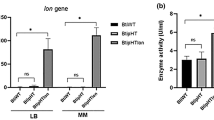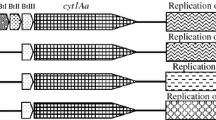Abstract
Improving the amount of protein endotoxins synthesized by Bacillus thuringiensis and B. sphaericus per unit of culture medium is important because higher yields typically correlate with higher insecticidal activity per unit weight of spore/toxin mixtures. Higher levels of synthesis can also result in larger crystals that could persist for longer periods in the environment. Improving endotoxin production in B. thuringiensis can be achieved by manipulating genetic elements that regulate protein synthesis at the transcriptional, translational, and even posttranslational levels. In the present study, we used a combination of genetic elements to improve yields of B. sphaericus 2362 binary toxin (Bin) in B. thuringiensis. Our results show that a 20-kDa chaperone-like protein, which occurs as the third open-reading frame in the cry11Aa operon, improves Bin yields when expression of the genes encoding this binary toxin is driven by the native bin promoter, cyt1A promoters, or a novel cyt1A-p/STAB-SD expression system, the latter of which yields maximal levels of Bin synthesis. The 20-kDa helper protein increased Bin toxin levels in B. thuringiensis by as much as 53% and concomitant toxicity by at least 90% when Bin was produced using the cyt1A promoters.


Similar content being viewed by others
Literature Cited
Adams LF, Visick JE, Whiteley HR (1989) A 20-kilodalton protein is required for efficient production of the Bacillus thuringiensis subsp. israelensis 27-kilodalton crystal proteins in Escherichia coli. J Bacteriol 171:521–530
Agaisse H, Lereclus D (1996) STAB-SD: A Shine-Dalgarno sequence in the 5′-untranslated region is a determinant of mRNA stability. Mol Microbiol 20:633–643
Baumann L, Broadwell AH, Baumann P (1988) Sequence analysis of the mosquitocidal toxin genes encoding 51.4- and 41.9-kilodalton proteins from Bacillus sphaericus 2362 and 2297. J Bacteriol 179:2045–2050
Baumann P, Clark MA, Baumann L, et al. (1991) Bacillus sphaericus as a mosquito pathogen: Properties of the organism and its toxin. Microbiol Rev 55:425–436
Charles J-F, Nielsen-LeRoux C, Delécluse A (1996) Bacillus sphaericus toxins: Molecular biology and mode of action. Annu Rev Entomol 41:451–472
Gee B, Bideshi D, Moar WJ, et al. (1998) Differential effects of helper proteins encoded by the cry2A and cry11A operons on the formation of Cry2A inclusions in Bacillus thuringiensis. FEMS Microbiol Lett 165:35–41
Laemmli UK (1970) Cleavage of structural proteins during the assembly of the head of bacteriophage T4. Nature 227:680–685
Lereclus D, Arantes O, Chaufaux J, et al. (1989) Transformation and expression of a cloned δ-endotoxin gene in Bacillus thuringiensis. FEMS Microbiol Lett 60:211–218
McLean KM, Whiteley HR (1987) Expression in Escherichia coli of a cloned crystal protein gene of Bacillus thuringiensis subsp. israelensis. J Bacteriol 169:1017–1023
Park H-W, Bideshi DK, Federici BA (2000) Molecular genetic manipulation of truncated Cry1C protein synthesis in Bacillus thuringiensis to improve stability and yield. Appl Environ Microbiol 66:4449–4455
Park H-W, Bideshi DK, Federici BA (2003) Recombinant STRAIN of Bacillus thuringiensis producing Cyt1A, Cry11B, and the Bacillus sphaericus binary toxin. Appl Environ Microbiol 69:1331–1334
Park H-W, Bideshi DK, Johnson JJ, et al. (1999) Differential enhancement of Cry2A versus Cry11A yields in Bacillus thuringiensis by use of the cry3A STAB mRNA sequence. FEMS Microbiol Lett 181:319–327
Park H-W, Bideshi DK, Wirth MC, et al. (2005) Recombinant larvicidal bacteria with markedly improved efficacy against Culex vectors of West Nile virus. Am J Trop Med Hyg 72:732–738
Park H-W, Delécluse A, Federici BA (2001) Construction and characterization of a recombinant Bacillus thuringiensis subsp. israelensis strain that produces Cry11B. J Invertebr Pathol 78:37–44
Park H-W, Ge B, Bauer LS, et al. (1998) Optimization of Cry3A yields in Bacillus thuringiensis by use of sporulation-dependent promoters in combination with the STAB-SD mRNA sequence. Appl Environ Microbiol 64:3932–3938
Rang C, Bes M, Lullien-Pellerin V, et al. (1996) Influence of the 20-kDa protein from Bacillus thuringiensis ssp. israelensis on the rate of production of truncated Cry1C proteins. FEMS Microbiol Lett 141:261–264
Servant P, Rosso ML, Hamon S, et al. (1999) Production of Cry11A and Cry11Ba toxins in Bacillus sphaericus confers toxicity toward Aedes aegypti and resistant Culex populations. Appl Environ Microbiol 65:3021–3026
Shao Z, Liu Z, Yu Z (2001) Effects of the 20-kilodalton helper protein on Cry1Ac production and spore formation in Bacillus thuringiensis. Appl Environ Microbiol 67:5362–5369
Thiery I, Hamon S, Delécluse A, et al. (1998) The introduction into Bacillus sphaericus of the Bacillus thuringiensis subsp. medellin Cyt1Ab1 gene results in higher susceptibility of resistant mosquito larva populations to B. sphaericus. Appl Environ Microbiol 64:3910–3916
Visick JE, Whiteley HR (1991) Effect of a 20-kilodalton protein from Bacillus thuringiensis subsp. israelensis on production of the CytA protein by Escherichia coli. J Bacteriol 173:1748–1756
Ward ES, Ellar DJ (1986) Bacillus thuringiensis var. israelensis δ-endotoxin. Nucleotide sequence and characterization of the transcripts in Bacillus thuringiensis and Escherichia coli. J Mol Biol 191:1–11
Wu D, Federici BA (1993) A 20-kilodalton protein preserves cell viability and promoters CytA crystal formation during sporulation in Bacillus thuringiensis. J Bacteriol 175:5276–5280
Wu D, Federici BA (1995) Improved production of the insecticidal CryIVD protein in Bacillus thuringiensis using cryIA(c) promoter to express the gene for an associated 20-kDa protein. Appl Microbiol Biotechnol 42:697–702
Yoshisue H, Yoshida K, Sen K, et al. (1992) Effects of Bacillus thuringiensis var. israelensis 20-kDa protein on production of the Bti 130-kDa crystal protein in Escherichia coli. Biosci Biotechnol Biochem 56:1429–1433
Acknowledgments
We thank Jeffrey J. Johnson for technical assistance during this study. This research was supported in part by a grant (to B.A.F.) from the United States National Institutes of Health (AI45817).
Author information
Authors and Affiliations
Corresponding author
Rights and permissions
About this article
Cite this article
Park, HW., Bideshi, D.K. & Federici, B.A. The 20-kDa Protein of Bacillus thuringiensis subsp. israelensis Enhances Bacillus sphaericus 2362 Bin Toxin Synthesis. Curr Microbiol 55, 119–124 (2007). https://doi.org/10.1007/s00284-006-0359-0
Received:
Accepted:
Published:
Issue Date:
DOI: https://doi.org/10.1007/s00284-006-0359-0




